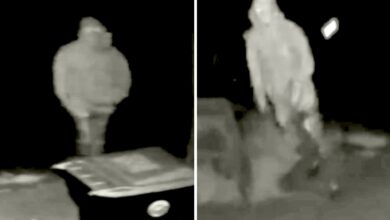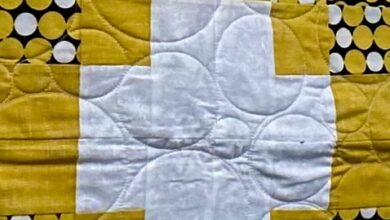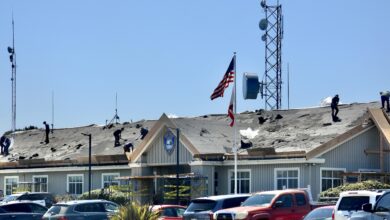Haul Road appeal held to Aug. 26
Four hours not enough time for Supes to consider appeal
Facing a packed house at Fort Bragg Town Hall where every seat was taken and the aisles were all full with 50 standing people, someone asked that everyone move up so that more people could get in from outside.
Mendocino County Board of Supervisors Chairman Dan Hamburg nixed this.
“We are up against the fire marshal at this point,” he said during Tuesday”s meeting.
The packed house gave supervisors an earful for four and a half hours about the issue of State Parks tearing up the northern remnants of the Haul Road. Most speakers opposed the $750,000-plus project to remove the remnants of the road between Ward Avenue and Ten Mile.
State Parks proposes to dig up and truck away 2.7 miles of three now isolated remnant road pieces, totaling 25,000 cubic yards of asphalt, gravel and roadbed. The state agency would also remove invasive European beach grass and some iceplant.
State Parks, which faced nearly unanimous speaker opposition at two previous meetings, was supported this time by a half dozen locals representing local, state and national environmental groups, including Audubon, the Sierra Club and the California Native Plant Society.
Hamburg”s gavel got a lot of use. The chairman cut off every speaker at exactly three minutes and silenced fellow supervisors in favor of holding all questions until the end. Supervisors managed to take all input from the public and close the public hearing, however they ran out of time for their own discussion. They called and got a half-hour of grace time from the Fort Bragg City Council to delay a joint meeting which had been set for 3 p.m. But the extra half-hour wasn”t enough.
The matter was continued to a special meeting set for Monday, Aug. 26 at the Board of Supervisors chambers in Ukiah. Supervisors will decide then whether to uphold or deny the Westport Municipal Advisory Council”s appeal of the approval of the road removal by the county”s coastal zone administrator.
Comments
With public testimony taking up the entire day, only two of the five supervisors stated how they were leaning. Supervisor Dan Gjerde pointed out that the Haul Road has been designated as part of the California Coastal Trail since 1995.
Gjerde said State Parks” position that a walking trail through the dunes isn”t compatible with the preserve isn”t encouraging when asking or in some cases demanding that private property owners set aside their land for the Coastal Trail. He said that just because state and federal agencies had opposed a public trail through the park in the past didn”t make that the final word.
“Agencies can change their positions over time. This does not mean that a little trail cannot be built 5, 10 or 15 years down the road. Part of our job is to be a voice for community positions. In this community we support the California Coastal Trail.
“We need to stand firm for the trail.”
On the other side, Supervisor John McCowen accepted State Parks” arguments that the habitat was too sensitive to keep the Haul Road. He was content with State Parks” designation of the beach and Highway 1 as the Coastal Trail between Ten Mile River and Ward Avenue.
“This board does stand solidly in favor of the Coastal Trail,” he said, refuting Gjerde. “The beach through the park is designated as the Coastal Trail.”
The short disagreement between the supervisors mirrored what had gone on in public discussion from 10 a.m. to 3:15 p.m. on Tuesday.
State Parks has offered only one option to their project, without giving alternatives to pick from, which is common in such projects.
County staff told supervisors they could construct conditions that Parks would need to follow should supervisors decide to approve the project.
The public, including several local environmentalists, said State Parks should restore public access as a way to enhance the area and attract visitors. They pointed to other areas of the state where dune trails have been improved and maintained in recent years.
“Throughout the course of the day I”ve heard it”s impossible [to restore a trail through the dunes],” said Judy Tarbell.
“We have wonderful new technology resources, some of which just came in recently. Parks needs to enter into the new age of finding ways to bring the public into sensitive areas that are both good for the public and good for preservation,” Tarbell said.
State Parks and its environmental supporters said the science supports tearing the road out as a critical step toward saving a very special area and three key endangered species.
“I think we need to be looking at things in the context of climate change. Sea level rise is going to inundate the foredunes,” said Judith Vidaver.
“Since the road is going to be going anyway, we should do it in a controlled manner and not have that road, which is asphalt, impacting the dunes in little tiny pieces. Chunks of the road are already showing up on Seaside Beach,” said Vidaver.
Seaside Beach is located north of Ten Mile River.
Bill Heil said now is the time to fix a historical wrong.
“There was a mistake made in 1906 or whenever, when they decided they had to get that whole woods up at Ten Mile to the mill, through those dunes that were useless because they didn”t grow any trees,” said Heil.
“If it was still possible, I”d say keep the Haul Road. It”s not possible,” said local native plant expert Teresa Sholars. “The science that the WMAC has set forth is totally inaccurate.”
Opponents of the project said removing the road would drain wetlands, kill endangered species and perhaps uncover toxins in the old railroad bed beneath the road. They said the removal would unleash a moving mountain of sand and wreck an environment that has been relatively stable for nearly a century.
Many accused State Parks of deliberately neglecting the road and slowly strangling access over the years in defiance of promises they made when the area was created.
“Their goal all along was to be right here where we are today, pulling that road out. Please don”t let them do it,” said Paul Clark.
Opponents of the project found the new idea of calling the beach the California Coastal Trail instead of the Haul Road to be an insult to the idea of any coastal trail that people can actually use. The wet beach is dangerous in the winter and the beach isn”t really accessible to many hikers, especially the handicapped. State Parks plans to create new ADA parking and a wheelchair trail at Ward Avenue in Cleone.
Plants and birds
Three rare species are at the heart of the issue of whether there should be actual trails through the dunes; the Western snowy plover, Menzies wallflower and Howell”s spineflower. State Parks presented science that showed that the project could benefit all three if the road removal indeed turns back the clock on changed conditions and starts dunes moving naturally again.
The road remnants and the piles of sand created by European Beach Grass are said to block Western Snowy Plover from leaving the beach. Remove the road and beach grass and plovers will be able to move about and survive.
“They don”t go inland unless they can access by feet,” said biologist Ron LeValley, a project supporter.
LeValley said the first nest in many years was found recently.
“Somebody with dogs walked through the middle of it and the chicks disappeared,” he said.
Many feel that snowy plover are fighting a losing battle. Even if people and dogs are removed from the area, the hapless plover”s eggs and young are devoured by a long list of predators whose numbers have seen huge increases due to humans: feral cats, ravens, seagulls, skunks, raccoons and non-native foxes. Hungry native hawks, kites and osprey, which must compete with the humanity enhanced denizens, also find plover and their young tasty.
In many areas of California and Oregon, programs to poison ravens, foxes and other predators are being used in desperate efforts to rescue plover, which often lays its camouflaged eggs in footprints in the open sand. Tens of millions of grant money has been spent studying the plover and trying to find ways to save it in its widespread, but divided habitat. Some scientists have argued that the plover isn”t really endangered across its entire habitat.
Howell”s Spineflower, a tiny annual flower in the buckwheat family, exists only in MacKerricher State Park and a few adjacent private properties north of Ward Avenue. It is unknown if it ever existed outside the north MacKerricher area. Horse and human trails have been found to injure this species, as well as stable dunes and invasive species like iceplant. But the road removal project itself would also kill some spineflower.
Deer are one of the prime enemies of the Menzies wallflower, a member of the mustard family that actually holds sand back like non-native iceplant and the dreaded European Beach grass. The Menzies is rare and often quite isolated in all the dune complexes in which it is found, mystifying some researchers.
Marcus Stenberg hadn”t signed up to speak but stood up at the end for the last comment and gave an otherwise hurried and tense room a laugh.
“I can”t get over the fact that here we have a room of grown-up people, we have got this money and we want to spend it on something. It”s just burning a hole in our pockets,” said Stenberg.
“We are trying to go and try to rearrange Mother Nature. It”s pretty obvious if you have been out there that Mother Nature does whatever she well pleases. You can spend all the money you want out there and you might as well be facing that north wind and trying to relieve yourself,” he said.




